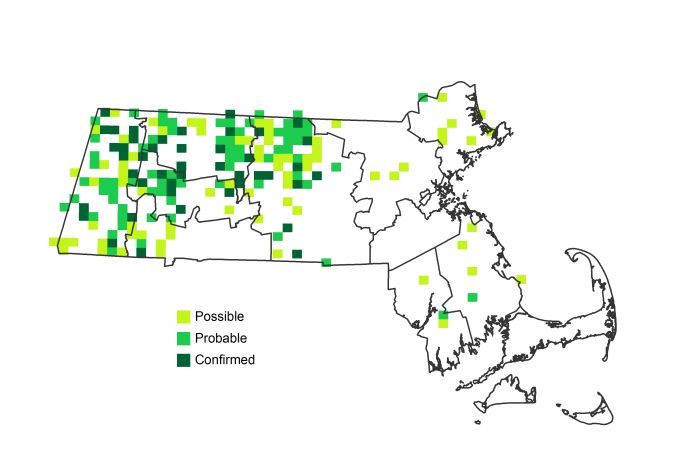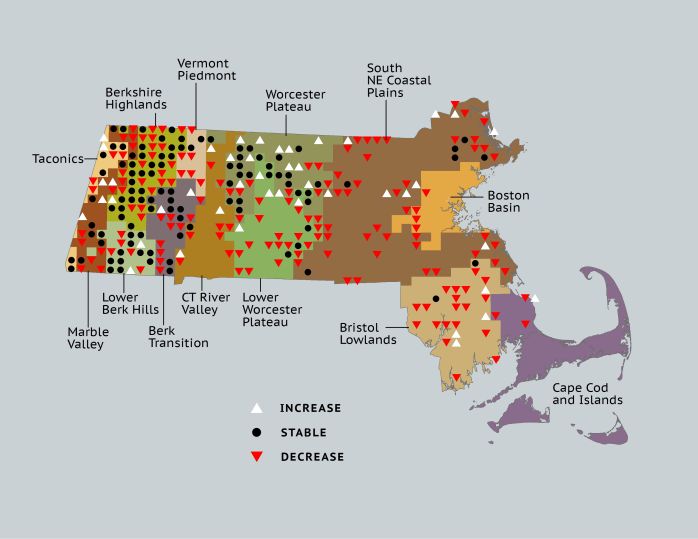Find a Bird
Canada Warbler
Wilsonia canadensis

Local and strongly declining
Conservation action urgent
State Wildlife Action Plan listed

“Wherever a streamlet of rushing water, deeply shaded by the great mountain laurel (Rhododendron maximum) was met with, there was the Canada Flycatcher to be found.” – John James Audubon, Birds of America
The Canada Warbler is a local breeder in Massachusetts, where it inhabits cool, moist forests with abundant undergrowth. The specificity of this bird’s habitat requirements may have placed it in a disadvantageous position as we enter the second decade of the twenty-first century. Swampy, brushy woodlands were seen as little more than sources of mosquitoes and plague by early European colonists; so much of the Canada Warbler’s habitat in eastern Massachusetts was logged and drained in short order. When farmers finally yielded their land back to the forest, Canada Warblers followed many of their fellow warblers in recolonizing the eastern reaches of the state. Whether this species can maintain its population in the face of new threats remains to be seen.
Historic Status
Any consideration of the historical status of the Canada Warbler in Massachusetts must be speculative since little has been written about this species in the state. One report, made to the Massachusetts legislature in 1839, says “The Canada Flycatcher, Musicapa canadensis, which...is often classed with the warblers, is not now uncommon in this state, however, it may have been in former years,” (Peabody 1839). That said, since it is a denizen of forested wetlands, its population has probably changed in concert with the deforestation and reforestation of Massachusetts through time, and one would expect the possibility that it might increase with the return of Beavers.
Atlas 1 Distribution
In Atlas 1, breeding Canada Warblers could be found where wetlands with rich understory are mixed with significant coniferous growth, and it is likely surprising to modern observers that they were found in 29% of the blocks surveyed in the state. Given these stringent habitat criteria, the western part of the state, not surprisingly, held the lion’s share of breeding records. The ecoregions west of the Connecticut River Valley had 64% block occupancy, and this accounted for 45% of the species' statewide footprint. The Berkshire Highlands had nearly 90% block occupancy during Atlas 1, an impressive total. The Connecticut River Valley had noticeably fewer, but the Worcester Plateau had more than 50% of its blocks hosting breeding individuals. In eastern Massachusetts, Canada Warblers were sparse but present as breeders on the Coastal Plains, and they had a notable presence in areas of the Bristol/Narragansett Lowlands, presumably due to the presence of Atlantic White Cedar swamps.
Atlas 2 Distribution and Change
There are many factors conspiring against the Canada Warbler, a much diminished breeder, now found in only 18% of the blocks surveyed. Though the species was still fairly widespread in western Massachusetts, all western ecoregions reported declines in the Canada Warbler for Atlas 2, and statewide their distribution change map is peppered with losses. The Worcester Plateau, which lost the species from 11 blocks but gained them in 12, had the most favorable numbers in the state. The southeastern Canada Warblers appeared to be in particularly steep decline: the Bristol/Narragansett Lowlands reported 5 abandoned blocks for every block with new breeding evidence.
Atlas 1 Map

Atlas 2 Map

Atlas Change Map

Ecoregion Data
Atlas 1 | Atlas 2 | Change | ||||||
Ecoregion | # Blocks | % Blocks | % of Range | # Blocks | % Blocks | % of Range | Change in # Blocks | Change in % Blocks |
Taconic Mountains | 10 | 62.5 | 3.6 | 11 | 44.0 | 5.8 | -2 | -13.3 |
Marble Valleys/Housatonic Valley | 20 | 51.3 | 7.1 | 12 | 30.8 | 6.3 | -8 | -20.5 |
Berkshire Highlands | 49 | 89.1 | 17.4 | 30 | 54.5 | 15.9 | -19 | -35.8 |
Lower Berkshire Hills | 17 | 60.7 | 6.0 | 15 | 48.4 | 7.9 | -3 | -11.1 |
Vermont Piedmont | 11 | 64.7 | 3.9 | 3 | 17.6 | 1.6 | -6 | -50.0 |
Berkshire Transition | 22 | 57.9 | 7.8 | 18 | 45.0 | 9.5 | -8 | -25.8 |
Connecticut River Valley | 8 | 14.3 | 2.8 | 6 | 9.2 | 3.2 | -4 | -8.3 |
Worcester Plateau | 40 | 51.3 | 14.2 | 52 | 59.1 | 27.5 | 1 | 2.1 |
Lower Worcester Plateau | 29 | 39.2 | 10.3 | 17 | 21.3 | 9.0 | -15 | -27.8 |
S. New England Coastal Plains and Hills | 47 | 17.4 | 16.7 | 18 | 6.4 | 9.5 | -31 | -13.7 |
Boston Basin | 4 | 7.1 | 1.4 | 0 | 0.0 | 0.0 | -4 | -7.3 |
Bristol and Narragansett Lowlands | 21 | 19.8 | 7.5 | 6 | 5.3 | 3.2 | -15 | -14.9 |
Cape Cod and Islands | 3 | 2.2 | 1.1 | 1 | 0.7 | 0.5 | -2 | -1.7 |
Statewide Total | 281 | 29.0 | 100.0 | 189 | 18.2 | 100.0 | -116 | -14.0 |
Notes
The Canada Warbler shows a significant decreasing Breeding Bird Survey trend in Massachusetts, in the New England/Mid-Atlantic Region, and in the Eastern US overall. There seem to be many factors conspiring to further the decline of this species – from white-tailed deer overgrazing to possible habitat degradation on the wintering grounds.



